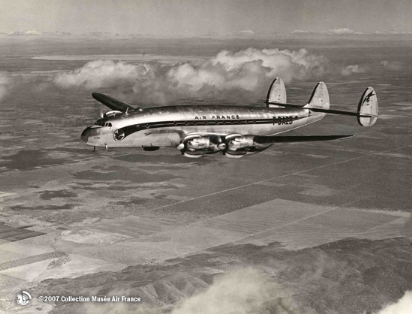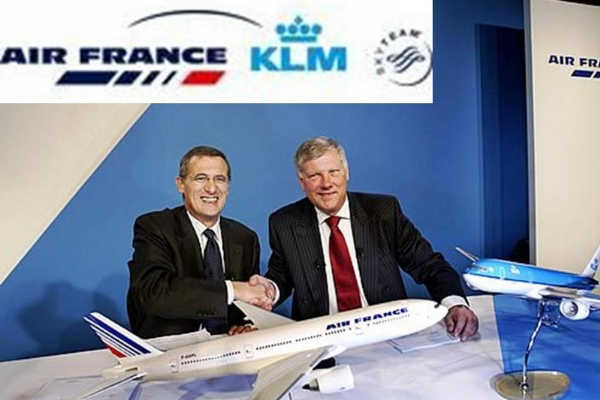|


NGUYEN Kim - MARTOT Cédric - PALLIN
Olivier
PIZZONI Nicolas - ZAPPULLA Damien
ESCT - Promo 2008 - DA
![]()
Introduction
I) Company profile
v Air France: Background
v KLM Royal Dutch Airline: Background
v Air France - KLM Group: `Highways To
Success'
v Mission Statement
v Vision 2010
v SWOT
II) Successful merger through network
management
v New Business Model (course network
strategy)
v The merger becomes a necessity
v Results and next major challenges
III) Sky Team Alliance: «Miles» your
flight
v Skyteam : Mile's your flight !
v Connecting strategy to relationship
IV) Air France - KLM: new leader of low cost
airlines?
v Low cost traffic isn't marginal!
v Transavia: Air France-KLM strikes back (Netherlands
low cost airline company)
![]()
Introduction
Few inventions have changed how people live and experience the
world as deeply as the invention of the aircraft. During the both World Wars,
government subsidies and demands for new aircrafts vastly improved techniques
for designing and building them. Now, the industry has progressed to the point
where it would be hard to think of life without air travel.
During dozen of years, the airline industry was either partly
or wholly government owned. This is still true in many countries, but in Europe
and in the United States, all major airlines are private. This major shift has
definitely changed the situation on the market for both airlines and
travelers.

If the airline industry could be described in three words,
they would be `intensively competitive market'. In recent years, more and more
airlines have appeared which has forced `historic' airlines to enhance their
competitiveness. Thanks to this process of democratization, more people than
ever before travel by airplane nowadays, and more airlines are starting to
offer longer non-stop flights.
At the time of global warming, it appears that the air travel
growth contributes significantly to climate change. Globally, the world's
16,000 commercial jet aircraft generate more than 600 million tones of carbon
dioxide (CO2), the world's major greenhouse gas, per year. Indeed,
aviation generates nearly as much CO2 annually as that from all
human activities in Africa.
At the beginning of the century, it was about technical
challenge. Then, at the turning point of the twenty-first century, the airline
industry is facing the environmental challenge... the most critical challenge
of the humanity. Nowadays, the sustainable development is not just a notion but
a real objective.
To the people who see the possibilities,
And who, sometimes with courage, sometimes with faith and
hope -
But always with effort, perseverance, and energy
(despite self-doubt) -
Strive to make the possible become reality.
Dreams can come true.
I) Company profile
Air France: Background
On 7 October 1933, five French airlines merged to become
officially Air France. These airlines were Air Orient, Air Union,
Société générale de transport aérien
(formerly Farman), the CIDNA (formerly Franco-Roumaine) and Aéropostale.

1946-1960: Soaring High
At the end of the war, Air France renewed its fleet, became
state-owned and introduced scheduled services to New-York. First hostesses were
hired in 1946..
In 1948, an act of parliament created Compagnie Nationale Air
France on June 1948. Air France became then a state-owned carrier. Max Hymans
was appointed CEO of Air France. During 13 years, he implemented a policy to
modernize the fleet with the introduction of state-of-the art jet aircraft.
On 12 November 1952, Air Inter was founded with the aim of
«promoting a coherent network of domestic air routes».
1960-1970: The Jet Era
On 23 February 1960, the French government transferred Air
France's domestic monopoly to Air Inter, compensated by a stake in Air
Inter.
In 1963, Air France had to share routes with its private
sector rivals. In fact, the French government decided the division based on a
law. Under this act, Air France had to withdraw all services for many routes
which were exclusively allocated to the newly formed Union de Transport
Aérien (UTA).
1970-1990: Maturity
In 1976, Air France operated its inaugural supersonic
transport (SST) service on the Paris Charles de Gaulle to Rio route.
By 1983, Air France was the fourth-largest scheduled passenger
airline and the second-largest scheduled freight carrier in the world.
1990-2004: The Merger
Air France, UTA and Air Inter were merged into the new holding
company, Air France Group. This second merger reflected the 1933 merger. The
French government supported the creation of a national carrier to counter
potential threats, resulting from the liberalisation of the EU's internal air
transport market.
The Head Office was relocated to Roissy at the heart of its
operations. This major change was mainly due to Stephen Wolf, a former United
Airlines CEO, appointed as adviser to the Chairman, Christian Blanc. Despite
this, Air France had to wait until 1997 to become again profitable.
In 1999, the status of Air France changed accordingly and the
airline evolved from a national carrier to an Airline major.

In 2000, the SkyTeam global alliance was set up. SkyTeam
offers one of the world's most extensive networks, with four strategically
located hubs in Asia, the United States, Latin America and Europe.
On 5 may 2004, Air France and KLM tied the knot: two of
Europe's oldest airlines which had both witnessed the dawn of international air
transport.
2004-2007: Open Skies
On 17 October 2007, Air France and Delta Air Lines signed a
joint venture agreement to share revenues and costs on their trans-Atlantic
routes. By 2010, the agreement will be extended to all trans-Atlantic flights
operated by Air France and Delta between Europe and the Mediterranean on one
side and North America on the other side.
| 

